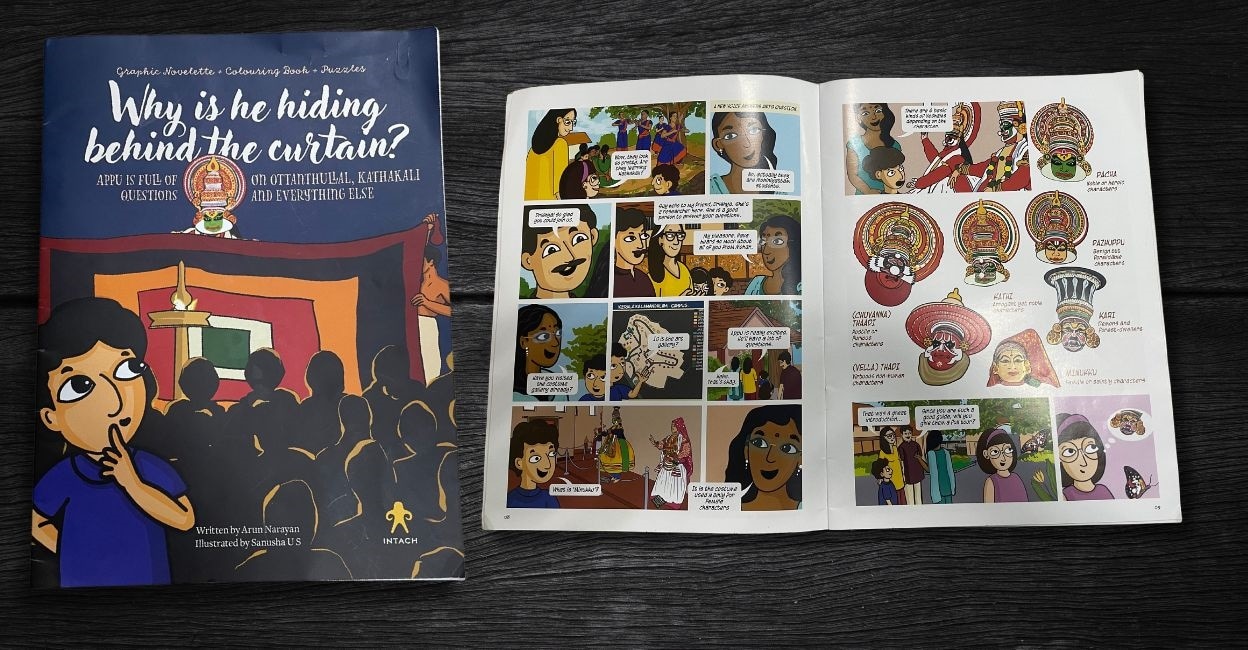'Why is He Hiding Behind the Curtain': A visual journey through Kerala’s traditional arts

Mail This Article
How many of us are familiar with the various art forms of Kerala and their basic principles? Not many, especially among the newer generation of children. The different forms of 'Ottanthullal' and the mesmerising performances of 'Kathakali' might not be well-known to most. Addressing this gap is the innovative graphic novelette, 'Why is He Hiding Behind the Curtain', written by Arun Narayan and illustrated by Sanusha US, which aims to explain these traditional art forms.
The book follows the journey of Appu and his older sister, Anu, as their parents take them to Kerala Kalamandalam to meet the artists, gurus, and students of Kathakali. It also includes a brief recounting of the Kathakali play 'Kalyanasougandhikam', an excerpt from the Mahabharata where Bhima encounters his half-brother Hanuman while searching for a flower desired by Draupadi.
The book also guides readers through the history of 'Ottanthullal,' addressing questions that young minds might have. One of the book's greatest strengths is that, although it is primarily intended for children aged eight and above, it also serves as an excellent introduction to these art forms for adults as well.

Regarding the book's conceptualisation, author Arun explained, "I didn't initially set out to write about the art forms of Kerala. Both the illustrator, Sanusha, and I volunteer at INTACH (Indian National Trust for Art and Cultural Heritage). One of our tasks involves working with children, and we've observed that many are unaware of Kerala's cultural heritage. As a result, these children may develop the notion that their own land is uninteresting and begin to look up to other places."
The 32-page book is not just a story; it features stunning illustrations, engaging games, and painting activities at the end. Arun highlighted the decline in reading habits and suggested that the lack of interest in arts and culture might be due to poor presentation. "After adolescence, certain prejudices form about everything, but children don't have those biases. If cultural heritage is presented attractively to them, they will surely learn and appreciate it," Arun explained.

"As a graphic designer fascinated by comics since my childhood, my passion for design traces back to Tintin comics. Comic books possess a unique appeal that fascinates young minds," he emphasised. "The illustrations are particularly compelling, straightforward yet vibrant, coming alive with their simplicity and use of vivid colours."
"When it comes to illustrations, realism and simplicity are crucial. Vibrancy is also key. Detailing plays a significant role because it enhances believability, creating an alternative reality. This detailing is essential as it helps children understand real-world concepts, moving beyond fiction," said Arun.
Arun further elaborated that they had been planning to create a comic for the past 4-5 years. When this project initially came to them as a request for a colouring book, they saw an opportunity to merge both ideas. Reflecting on a suitable theme, they recognised the rich potential of Kerala's art forms for comics and colouring due to their vibrant nature. He expressed concern that many young people in Kerala nowadays lack faith in the value of their cultural heritage. One of the main motivations behind their comic book initiative is to help these youngsters appreciate the significance of their own heritage and realise its worth.
The book maintains a seamless narrative flow, presenting a familiar family story arc where children explore the diverse art forms of their state. However, Arun emphasises that the book does not aim to push children towards pursuing a career in arts. Instead, its goal is to cultivate an appreciation for their culture and heritage.


